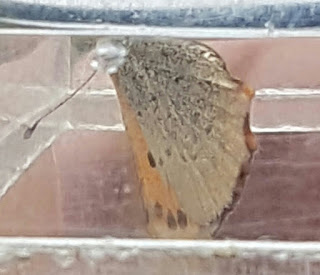Five of us spent a leisurely couple of hours exploring and I listed all the species we identified in that time. It was not a scientific survey, but we all had smatterings of wildflower knowledge, were all trying to learn our bumblebees, and John could recognise birds from their song which as far as I'm concerned is a skill bordering on magic.
We easily made a list of 66 species, over 50 of which were native:
- Wych elm
- Common lime
- Ash
- Silver birch
- Holly
- Alder
- Elder
- Scots pine
- Goat willow
- Yew
- Pedunculate oak
- Rowan
- Ivy
- Stinging nettle
- Goosegrass
- Bramble
- Raspberry
- Creeping buttercup
- Meadow buttercup
- Ribwort plantain
- White clover
- Red clover
- Lesser stitchwort
- Wood avens
- Willowherb
- Wood forget-me-not
- Herb robert
- Meadow cranesbill
- Garlic mustard
- Dandelion
- Sanicle
- St Johns Wort
- Coltsfoot
- Common ragwort
- Broom
- Foxglove
- Daisy
- Cocksfoot grass
- Wood pigeon
- Jackdaw
- Magpie
- Wren
- Robin
- Blackcap
- Goldcrest
- Swift
- Song thrush
- Blackbird
- Chiff chaff
- Wood wasp
- Common carder bee
- Buff tailed bumblebee
- Tree bumblebee
- Rabbit
- Grey squirrel
- Sycamore
- Norway maple
- Horse chestnut
- Sweet chestnut
- Beech
- Turkey oak
- Deodar cedar
- Blue Atlas cedar
- Rhododendron ponticum
- Monkey puzzle
- Green alkanet
- Himalayan balsam
- Japanese knotweed
 |
| We didn't know our beetles! Photo by Kay |
Some of the non-natives were superb trees from when the grounds were formal parkland. There were large numbers of the recently-arrived Tree bumblebee. We also noted the invasive Himalayan balsam and Japanese knotweed, and arranged to contact the Council about the latter.
The range of old trees was spectacular, as was the diversity of flowers, including woodland flowers like Sanicle which indicates ancient woodland. There were plenty more flowers, grasses, mosses, ferns and invertebrates which we didn't have time or skill to identify. We felt we'd had a glimpse into a treasury on our doorstep.
You can see future events and sign up on the Wild Reekie Meetup page. You can also follow me on twitter at @eleanormharris or email me at eleanormharris@gmail.com.




























